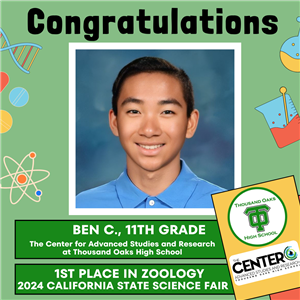Congratulations Ben C. of TOHS, First Place Awardee at the California State Science Fair!
 Congratulations to 11th grader Ben C., a student in The Center for Advanced Studies and Research at Thousand Oaks High School who earned 1st place in Zoology at the 2024 California State Science Fair for his research on The Synergistic Effect of Omega-3 Fatty Acids (DHA and EPA) and Zinc Picolinate on Traumatic Brain Injury in Galleria mellonella.
Congratulations to 11th grader Ben C., a student in The Center for Advanced Studies and Research at Thousand Oaks High School who earned 1st place in Zoology at the 2024 California State Science Fair for his research on The Synergistic Effect of Omega-3 Fatty Acids (DHA and EPA) and Zinc Picolinate on Traumatic Brain Injury in Galleria mellonella.
The California Science & Engineering Fair is the final science fair of the academic year for students throughout the State of California in grades 6 - 12, serving California's future scientists and engineers since 1952. The fair is hosted by the California Science and Engineering Foundation. This year there were 857 participants from 344 schools throughout the State presenting 704 projects.
In addition to his accomplishments at the State Science Fair, Ben previously earned the honor of competing in the Regeneron International Science and Engineering Fair (ISEF) 2024, which will be held May 12-17 in Los Angeles. This opportunity comes from his award-winning research presented at the Ventura County Science Fair. This is the second consecutive year that the Ventura County Science Fair has provided one student the opportunity to compete in the prestigious Regeneron ISEF competition, and it’s the second consecutive year a student from The Center for Advanced Studies and Research at Thousand Oaks High School was selected.
More About Ben’s Award-Winning Project:
BMED080 - Omega-3 and Zinc Synergy on TBI in G. mellonella
Every 15 seconds, a person suffers a traumatic brain injury (TBI), a leading cause of mortality and lifelong disability worldwide. Despite its prevalence, effective therapeutic treatments tailored to enhance TBI recovery remain elusive, with current strategies confined to preventative measures and post-TBI rehabilitation. This experiment introduced a novel model for TBI using Galleria mellonella and tested the hypothesis that the synergistic effect of omega-3 fatty acids (docosahexaenoic acid [DHA] and eicosapentaenoic acid [EPA]) combined with zinc picolinate would increase the efficiency of recovery from TBI. For the experimental setup, TBI was induced in Galleria mellonella using a high impact trauma (HIT) device. They were then divided into four groups in separate petri dishes: an untreated control and three groups treated post-TBI with varying doses of omega-3 fatty acids (0-0.4 mL), zinc picolinate (0-0.4 g), and their synergy. Results showed that 0.1 mL of omega-3 fatty acids combined with 0.1 g of zinc picolinate significantly enhanced Galleria mellonella survival rates, achieving 29% to 100% survival. One-way ANOVA confirmed the efficacy of the synergistic treatment, revealing significant improvements with a p-value < 0.05. This dosage achieved a score of 0 on the modified neurological severity score (mNSS) test, indicating behavioral restoration of cognitive function. Microscopic examination of brain tissue stained with cresyl violet revealed restoratory activity in cortex volume. These findings revealed that the optimal dose of 0.1 mL of omega-3 fatty acids and 0.1 g of zinc picolinate increased recovery from TBI in Galleria mellonella, offering promising insights for developing accessible, nutrition-based therapies to improve outcomes for TBI patients.
Click here to view his digital projectboard on the Regeneron ISEF website.
Congratulations, Ben and best of luck at the upcoming Regeneron ISEF competition!

